Exploring Poetry: A Comparison of Reading Text and Viewing Performance
VerifiedAdded on 2023/03/30
|5
|936
|259
Essay
AI Summary
This essay explores the differences between experiencing poetry through reading and viewing live performances, focusing on poems by Jamaal May and Patricia Smith. It argues that reading allows for personal imagination and detailed analysis of poetic devices like rhyme and repetition, while performance provides emotional depth through nonverbal cues and tonal variations. The analysis highlights how each method offers unique benefits, catering to different audience preferences and enhancing the overall understanding and appreciation of poetry. The essay concludes that live performances, such as Patricia Smith's use of tonal variation and Jamaal May's nonverbal communication, significantly impact the delivery and interpretation of the poem's message.
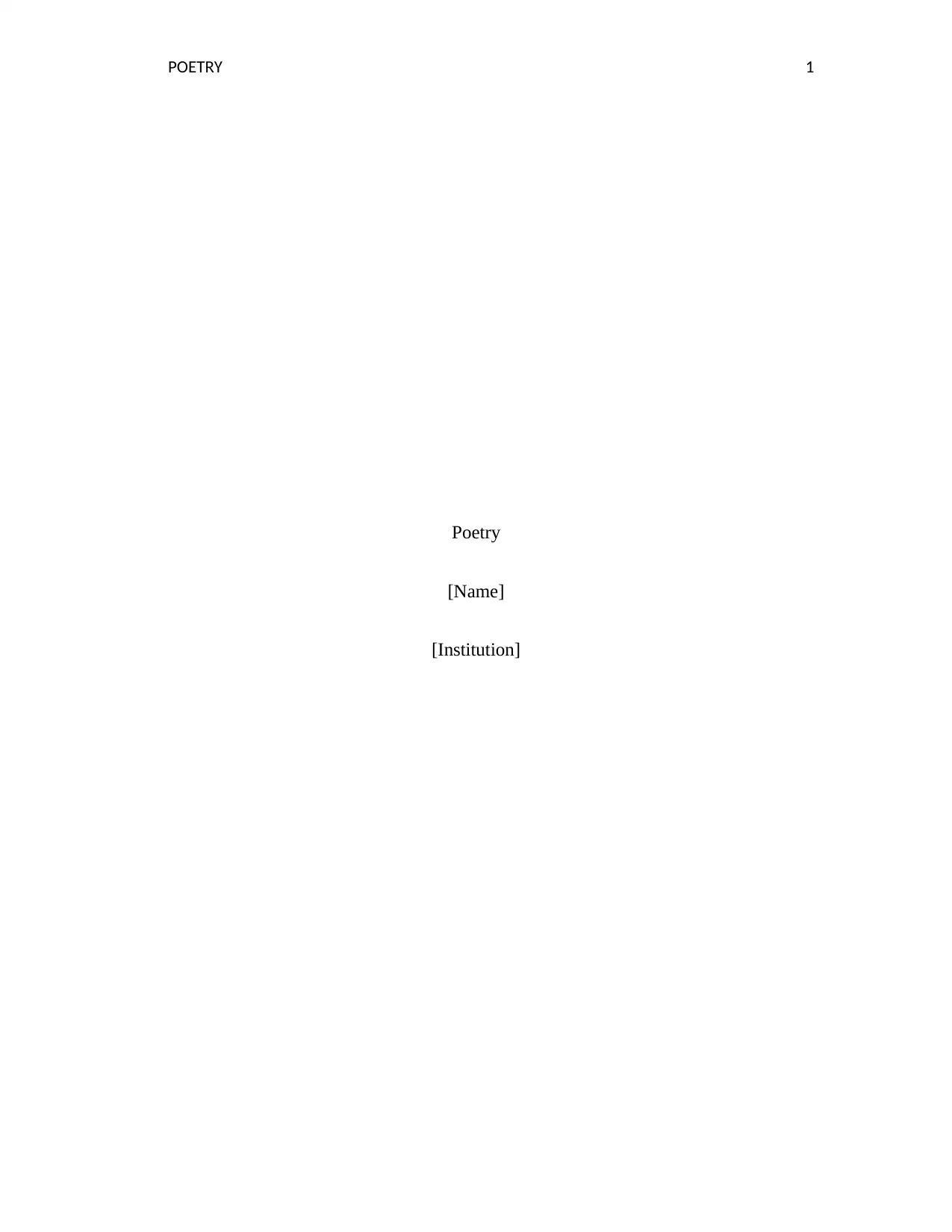
POETRY 1
Poetry
[Name]
[Institution]
Poetry
[Name]
[Institution]
Paraphrase This Document
Need a fresh take? Get an instant paraphrase of this document with our AI Paraphraser
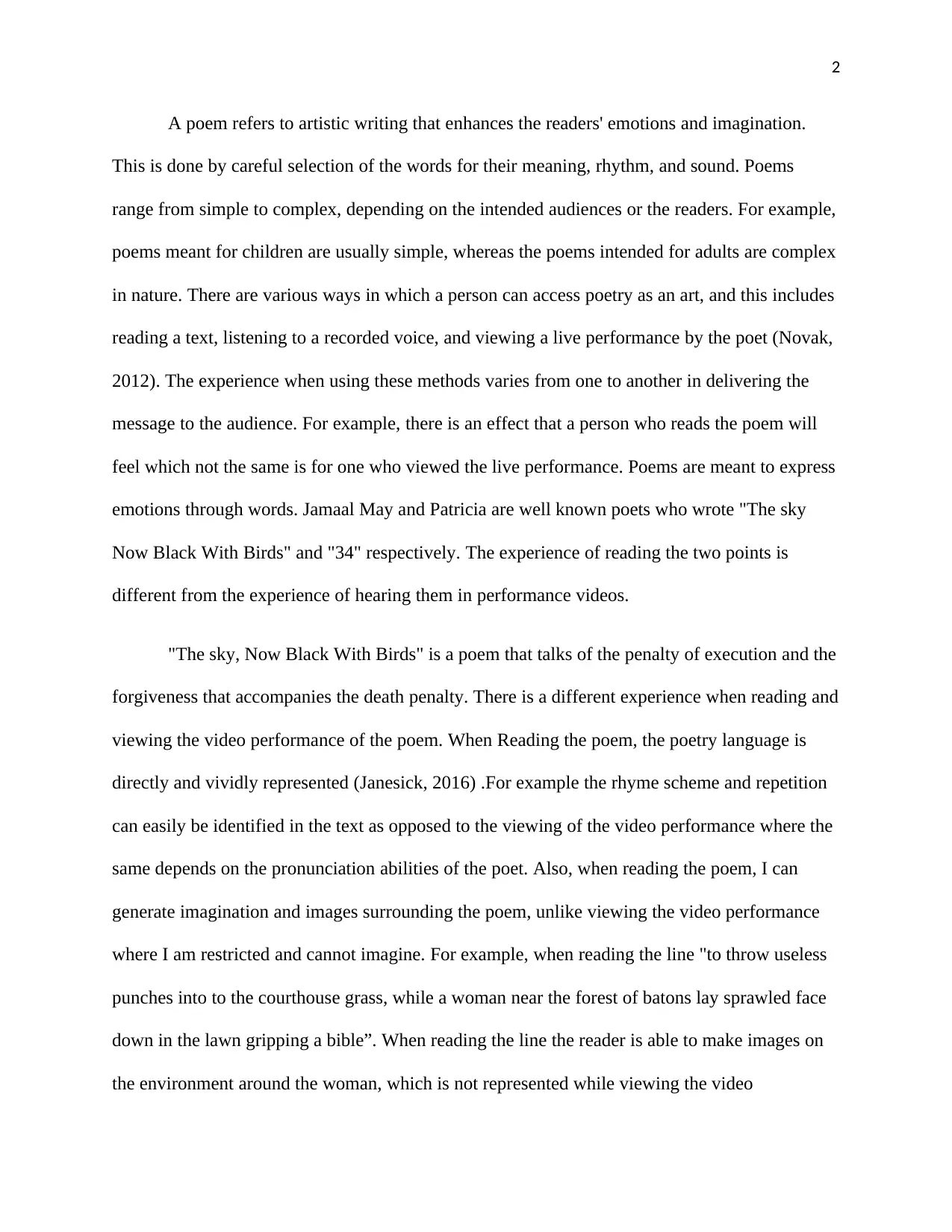
2
A poem refers to artistic writing that enhances the readers' emotions and imagination.
This is done by careful selection of the words for their meaning, rhythm, and sound. Poems
range from simple to complex, depending on the intended audiences or the readers. For example,
poems meant for children are usually simple, whereas the poems intended for adults are complex
in nature. There are various ways in which a person can access poetry as an art, and this includes
reading a text, listening to a recorded voice, and viewing a live performance by the poet (Novak,
2012). The experience when using these methods varies from one to another in delivering the
message to the audience. For example, there is an effect that a person who reads the poem will
feel which not the same is for one who viewed the live performance. Poems are meant to express
emotions through words. Jamaal May and Patricia are well known poets who wrote "The sky
Now Black With Birds" and "34" respectively. The experience of reading the two points is
different from the experience of hearing them in performance videos.
"The sky, Now Black With Birds" is a poem that talks of the penalty of execution and the
forgiveness that accompanies the death penalty. There is a different experience when reading and
viewing the video performance of the poem. When Reading the poem, the poetry language is
directly and vividly represented (Janesick, 2016) .For example the rhyme scheme and repetition
can easily be identified in the text as opposed to the viewing of the video performance where the
same depends on the pronunciation abilities of the poet. Also, when reading the poem, I can
generate imagination and images surrounding the poem, unlike viewing the video performance
where I am restricted and cannot imagine. For example, when reading the line "to throw useless
punches into to the courthouse grass, while a woman near the forest of batons lay sprawled face
down in the lawn gripping a bible”. When reading the line the reader is able to make images on
the environment around the woman, which is not represented while viewing the video
A poem refers to artistic writing that enhances the readers' emotions and imagination.
This is done by careful selection of the words for their meaning, rhythm, and sound. Poems
range from simple to complex, depending on the intended audiences or the readers. For example,
poems meant for children are usually simple, whereas the poems intended for adults are complex
in nature. There are various ways in which a person can access poetry as an art, and this includes
reading a text, listening to a recorded voice, and viewing a live performance by the poet (Novak,
2012). The experience when using these methods varies from one to another in delivering the
message to the audience. For example, there is an effect that a person who reads the poem will
feel which not the same is for one who viewed the live performance. Poems are meant to express
emotions through words. Jamaal May and Patricia are well known poets who wrote "The sky
Now Black With Birds" and "34" respectively. The experience of reading the two points is
different from the experience of hearing them in performance videos.
"The sky, Now Black With Birds" is a poem that talks of the penalty of execution and the
forgiveness that accompanies the death penalty. There is a different experience when reading and
viewing the video performance of the poem. When Reading the poem, the poetry language is
directly and vividly represented (Janesick, 2016) .For example the rhyme scheme and repetition
can easily be identified in the text as opposed to the viewing of the video performance where the
same depends on the pronunciation abilities of the poet. Also, when reading the poem, I can
generate imagination and images surrounding the poem, unlike viewing the video performance
where I am restricted and cannot imagine. For example, when reading the line "to throw useless
punches into to the courthouse grass, while a woman near the forest of batons lay sprawled face
down in the lawn gripping a bible”. When reading the line the reader is able to make images on
the environment around the woman, which is not represented while viewing the video
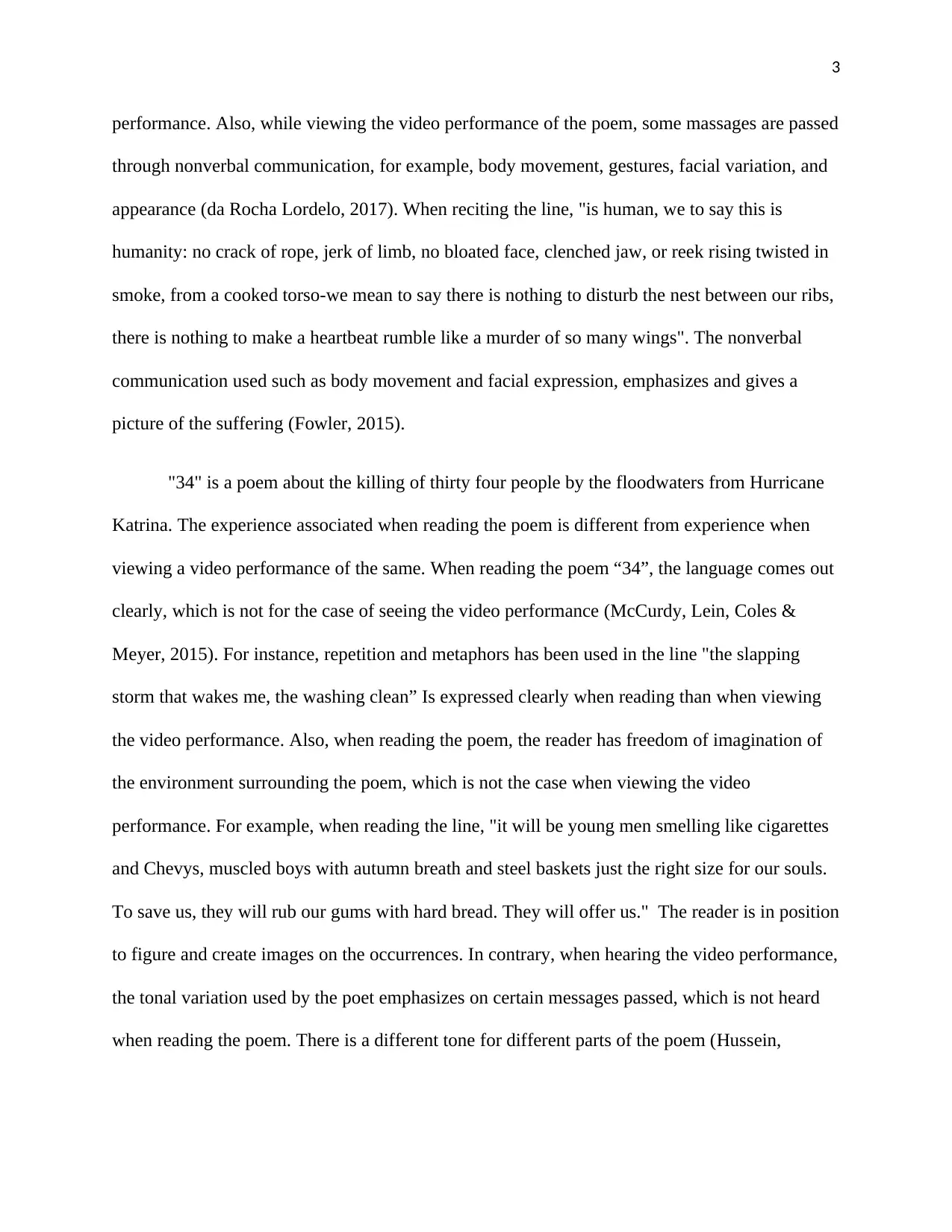
3
performance. Also, while viewing the video performance of the poem, some massages are passed
through nonverbal communication, for example, body movement, gestures, facial variation, and
appearance (da Rocha Lordelo, 2017). When reciting the line, "is human, we to say this is
humanity: no crack of rope, jerk of limb, no bloated face, clenched jaw, or reek rising twisted in
smoke, from a cooked torso-we mean to say there is nothing to disturb the nest between our ribs,
there is nothing to make a heartbeat rumble like a murder of so many wings". The nonverbal
communication used such as body movement and facial expression, emphasizes and gives a
picture of the suffering (Fowler, 2015).
"34" is a poem about the killing of thirty four people by the floodwaters from Hurricane
Katrina. The experience associated when reading the poem is different from experience when
viewing a video performance of the same. When reading the poem “34”, the language comes out
clearly, which is not for the case of seeing the video performance (McCurdy, Lein, Coles &
Meyer, 2015). For instance, repetition and metaphors has been used in the line "the slapping
storm that wakes me, the washing clean” Is expressed clearly when reading than when viewing
the video performance. Also, when reading the poem, the reader has freedom of imagination of
the environment surrounding the poem, which is not the case when viewing the video
performance. For example, when reading the line, "it will be young men smelling like cigarettes
and Chevys, muscled boys with autumn breath and steel baskets just the right size for our souls.
To save us, they will rub our gums with hard bread. They will offer us." The reader is in position
to figure and create images on the occurrences. In contrary, when hearing the video performance,
the tonal variation used by the poet emphasizes on certain messages passed, which is not heard
when reading the poem. There is a different tone for different parts of the poem (Hussein,
performance. Also, while viewing the video performance of the poem, some massages are passed
through nonverbal communication, for example, body movement, gestures, facial variation, and
appearance (da Rocha Lordelo, 2017). When reciting the line, "is human, we to say this is
humanity: no crack of rope, jerk of limb, no bloated face, clenched jaw, or reek rising twisted in
smoke, from a cooked torso-we mean to say there is nothing to disturb the nest between our ribs,
there is nothing to make a heartbeat rumble like a murder of so many wings". The nonverbal
communication used such as body movement and facial expression, emphasizes and gives a
picture of the suffering (Fowler, 2015).
"34" is a poem about the killing of thirty four people by the floodwaters from Hurricane
Katrina. The experience associated when reading the poem is different from experience when
viewing a video performance of the same. When reading the poem “34”, the language comes out
clearly, which is not for the case of seeing the video performance (McCurdy, Lein, Coles &
Meyer, 2015). For instance, repetition and metaphors has been used in the line "the slapping
storm that wakes me, the washing clean” Is expressed clearly when reading than when viewing
the video performance. Also, when reading the poem, the reader has freedom of imagination of
the environment surrounding the poem, which is not the case when viewing the video
performance. For example, when reading the line, "it will be young men smelling like cigarettes
and Chevys, muscled boys with autumn breath and steel baskets just the right size for our souls.
To save us, they will rub our gums with hard bread. They will offer us." The reader is in position
to figure and create images on the occurrences. In contrary, when hearing the video performance,
the tonal variation used by the poet emphasizes on certain messages passed, which is not heard
when reading the poem. There is a different tone for different parts of the poem (Hussein,
⊘ This is a preview!⊘
Do you want full access?
Subscribe today to unlock all pages.

Trusted by 1+ million students worldwide
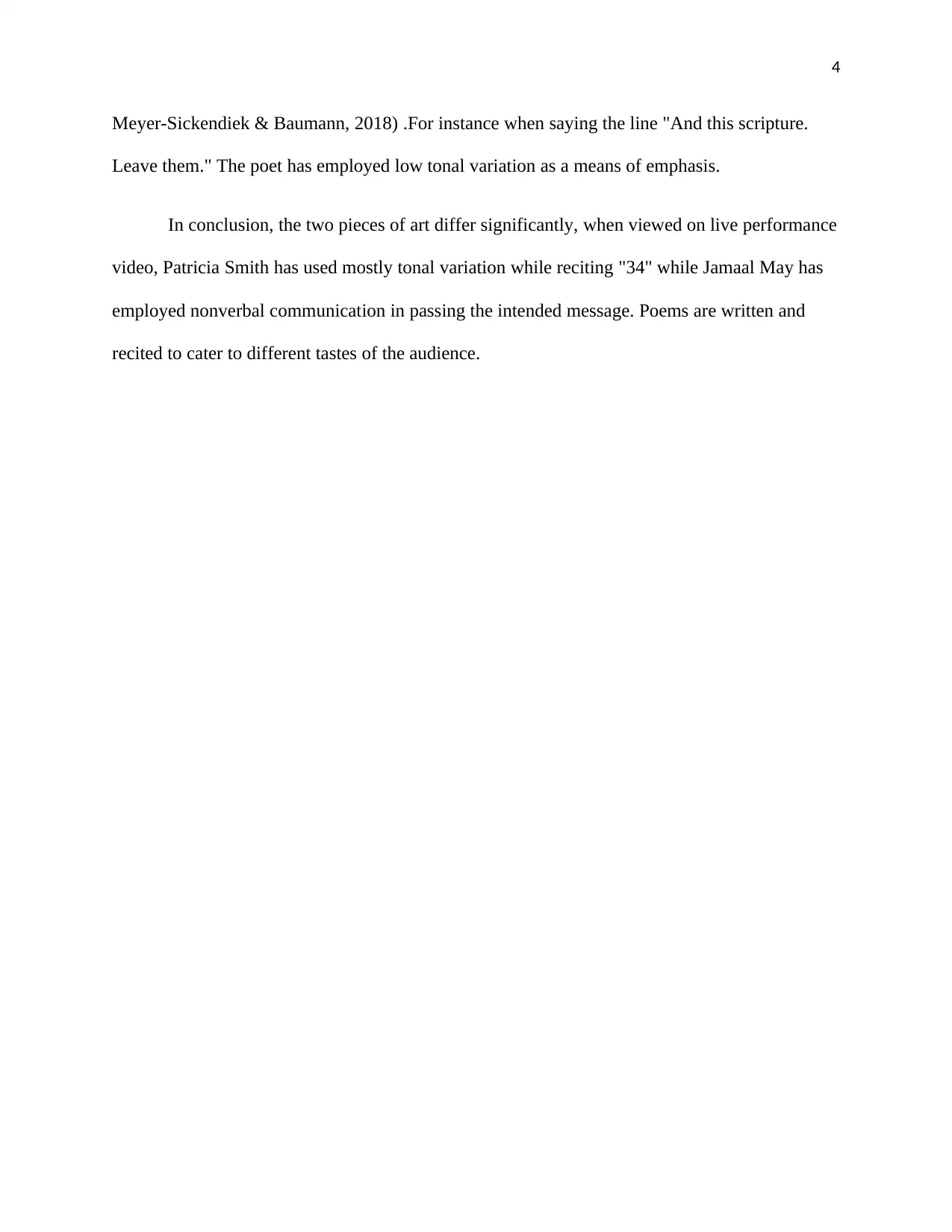
4
Meyer-Sickendiek & Baumann, 2018) .For instance when saying the line "And this scripture.
Leave them." The poet has employed low tonal variation as a means of emphasis.
In conclusion, the two pieces of art differ significantly, when viewed on live performance
video, Patricia Smith has used mostly tonal variation while reciting "34" while Jamaal May has
employed nonverbal communication in passing the intended message. Poems are written and
recited to cater to different tastes of the audience.
Meyer-Sickendiek & Baumann, 2018) .For instance when saying the line "And this scripture.
Leave them." The poet has employed low tonal variation as a means of emphasis.
In conclusion, the two pieces of art differ significantly, when viewed on live performance
video, Patricia Smith has used mostly tonal variation while reciting "34" while Jamaal May has
employed nonverbal communication in passing the intended message. Poems are written and
recited to cater to different tastes of the audience.
Paraphrase This Document
Need a fresh take? Get an instant paraphrase of this document with our AI Paraphraser
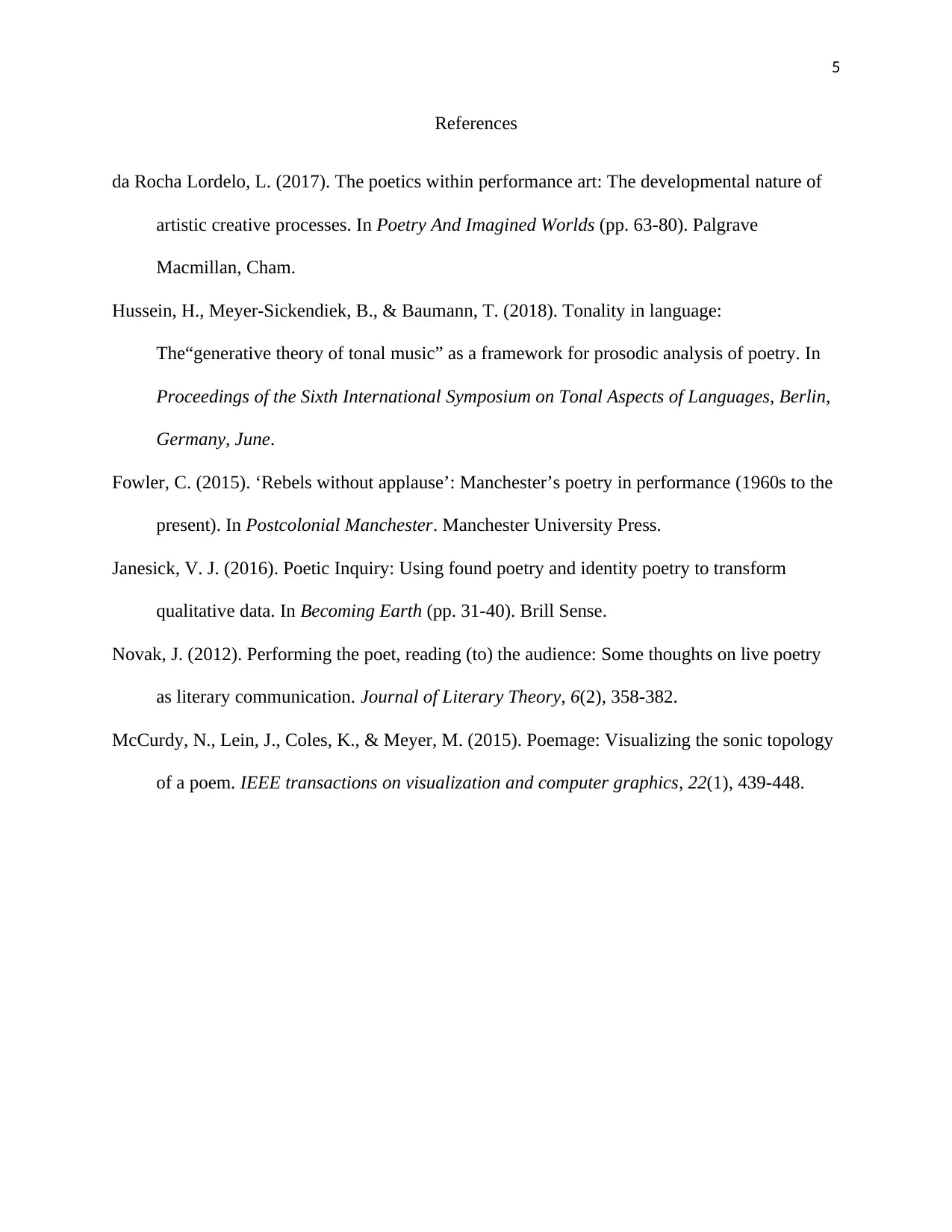
5
References
da Rocha Lordelo, L. (2017). The poetics within performance art: The developmental nature of
artistic creative processes. In Poetry And Imagined Worlds (pp. 63-80). Palgrave
Macmillan, Cham.
Hussein, H., Meyer-Sickendiek, B., & Baumann, T. (2018). Tonality in language:
The“generative theory of tonal music” as a framework for prosodic analysis of poetry. In
Proceedings of the Sixth International Symposium on Tonal Aspects of Languages, Berlin,
Germany, June.
Fowler, C. (2015). ‘Rebels without applause’: Manchester’s poetry in performance (1960s to the
present). In Postcolonial Manchester. Manchester University Press.
Janesick, V. J. (2016). Poetic Inquiry: Using found poetry and identity poetry to transform
qualitative data. In Becoming Earth (pp. 31-40). Brill Sense.
Novak, J. (2012). Performing the poet, reading (to) the audience: Some thoughts on live poetry
as literary communication. Journal of Literary Theory, 6(2), 358-382.
McCurdy, N., Lein, J., Coles, K., & Meyer, M. (2015). Poemage: Visualizing the sonic topology
of a poem. IEEE transactions on visualization and computer graphics, 22(1), 439-448.
References
da Rocha Lordelo, L. (2017). The poetics within performance art: The developmental nature of
artistic creative processes. In Poetry And Imagined Worlds (pp. 63-80). Palgrave
Macmillan, Cham.
Hussein, H., Meyer-Sickendiek, B., & Baumann, T. (2018). Tonality in language:
The“generative theory of tonal music” as a framework for prosodic analysis of poetry. In
Proceedings of the Sixth International Symposium on Tonal Aspects of Languages, Berlin,
Germany, June.
Fowler, C. (2015). ‘Rebels without applause’: Manchester’s poetry in performance (1960s to the
present). In Postcolonial Manchester. Manchester University Press.
Janesick, V. J. (2016). Poetic Inquiry: Using found poetry and identity poetry to transform
qualitative data. In Becoming Earth (pp. 31-40). Brill Sense.
Novak, J. (2012). Performing the poet, reading (to) the audience: Some thoughts on live poetry
as literary communication. Journal of Literary Theory, 6(2), 358-382.
McCurdy, N., Lein, J., Coles, K., & Meyer, M. (2015). Poemage: Visualizing the sonic topology
of a poem. IEEE transactions on visualization and computer graphics, 22(1), 439-448.
1 out of 5
Your All-in-One AI-Powered Toolkit for Academic Success.
+13062052269
info@desklib.com
Available 24*7 on WhatsApp / Email
![[object Object]](/_next/static/media/star-bottom.7253800d.svg)
Unlock your academic potential
Copyright © 2020–2025 A2Z Services. All Rights Reserved. Developed and managed by ZUCOL.